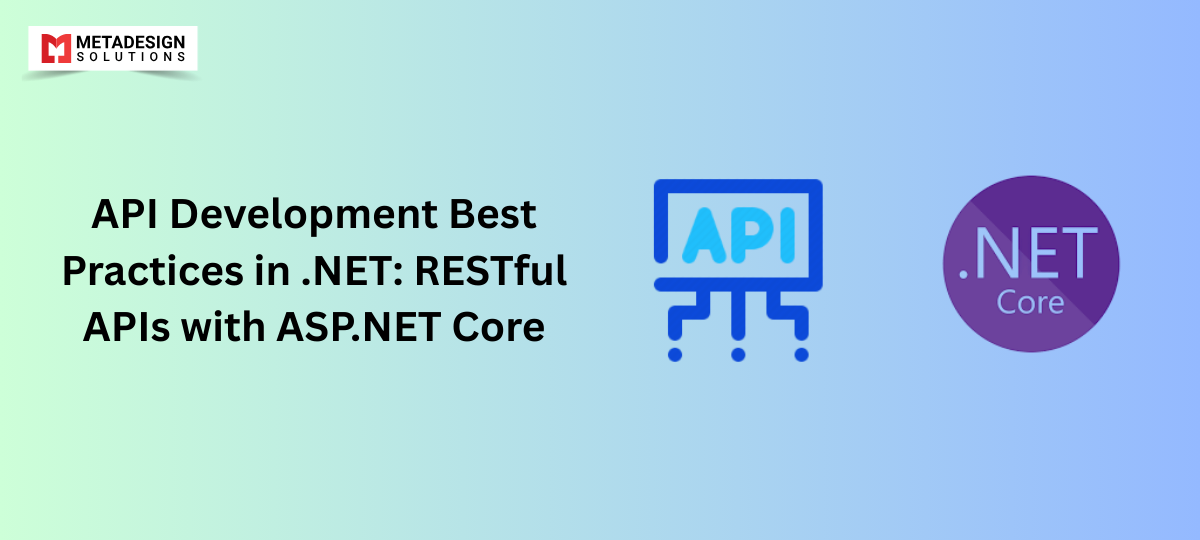Introduction
APIs play a crucial role in modern applications, enabling communication between different services and platforms. Whether it’s a web, mobile, or cloud application, well-structured APIs ensure scalability, security, and performance.
ASP.NET Core is a preferred framework for building RESTful APIs due to its lightweight architecture, cross-platform support, and high performance. Many businesses hire a .Many businesses hire a .NET development company to build secure and efficient APIs for their applications. Secure applications in .NET leverage features like authentication, authorization, and data encryption to ensure robust protection against threats.
In this guide, we will cover:
✅ What makes a RESTful API?
✅ How to build RESTful APIs with ASP.NET Core
✅ Best practices for API development
✅ Security, performance, and versioning strategies
If you are looking to hire .NET developers for API development, understanding these best practices will help ensure that your API is efficient, secure, and easy to maintain.
Understanding RESTful APIs
What is a RESTful API?
A RESTful API (Representational State Transfer) follows a set of architectural principles that ensure efficient client-server communication using HTTP methods.
✅ Key Features of RESTful APIs:
- Stateless – Each request is independent and does not rely on previous requests.
- Resource-Based – API endpoints represent resources (e.g., /users, /orders).
- Uses Standard HTTP Methods:
- GET → Retrieve data
- POST → Create new data
- PUT → Update existing data
- DELETE → Remove data
Businesses rely on .NET development services to build well-structured REST APIs that follow these principles.
Setting Up an ASP.NET Core REST API
Step 1: Create an ASP.NET Core API Project
To create a new ASP.NET Core Web API project, run the following command:
bash code:
dotnet new webapi -o MyApiProject
cd MyApiProject
dotnet run
This sets up a basic API project with Swagger support for testing.
Step 2: Define API Endpoints
Create a controller to handle API requests.
csharp code:
[ApiController]
[Route("api/[controller]")]
public class ProductsController : ControllerBase
{
private static readonly List<Product> Products = new List<Product>
{
new Product { Id = 1, Name = "Laptop", Price = 1200 },
new Product { Id = 2, Name = "Phone", Price = 800 }
};
[HttpGet]
public IActionResult GetProducts()
{
return Ok(Products);
}
[HttpGet("{id}")]
public IActionResult GetProductById(int id)
{
var product = Products.FirstOrDefault(p => p.Id == id);
if (product == null) return NotFound();
return Ok(product);
}
}
✅ Best Practices Used:
[ApiController] – Enables automatic request validation.
[Route(“api/[controller]”)] – Defines the API route dynamically.
Action methods return IActionResult – This makes response handling flexible and clear.
Best Practices for ASP.NET Core API Development
1. Use Meaningful Resource Names
Endpoints should represent nouns rather than verbs.
❌ Bad Example:
bash code:
GET /getProducts
POST /updateProduct
✅ Good Example:
GET /products
POST /products
2. Implement Status Codes Correctly
Use standard HTTP status codes for clarity.
Status Code | Meaning |
200 OK | Request successful |
201 Created | Resource created successfully |
400 Bad Request | Invalid request data |
404 Not Found | Resource not found |
500 Internal Server Error | Server error |
✅ Example:
csharp code:
if (product == null) return NotFound();
return Ok(product);
3. Use Dependency Injection for Better Maintainability
ASP.NET Core natively supports Dependency Injection (DI), making APIs loosely coupled and testable.
✅ Example: Register a service in Program.cs:
csharp code:
builder.Services.AddScoped<IProductService, ProductService>();
Inject it into the controller:
csharp code:
public class ProductsController : ControllerBase
{
private readonly IProductService _productService;
public ProductsController(IProductService productService)
{
_productService = productService;
}
}
4. Implement Pagination for Large Datasets
Avoid sending huge datasets in a single response. Implement pagination to improve performance.
✅ Example:
csharp
[HttpGet]
public IActionResult GetProducts(int page = 1, int pageSize = 10)
{
var pagedProducts = Products.Skip((page - 1) * pageSize).Take(pageSize);
return Ok(pagedProducts);
}
5. Secure Your API with Authentication & Authorization
Use JWT (JSON Web Tokens) for secure authentication.
✅ Install JWT Authentication:
bash code:
dotnet add package Microsoft.AspNetCore.Authentication.JwtBearer
✅ Configure in Program.cs:
csharp code:
builder.Services.AddAuthentication(JwtBearerDefaults.AuthenticationScheme)
.AddJwtBearer(options =>
{
options.Authority = "https://your-auth-provider.com";
options.Audience = "your-api";
});
✅ Secure an API Endpoint:
csharp code:
[Authorize]
[HttpGet]
public IActionResult GetSecureData()
{
return Ok("This is a secure endpoint");
}
📌 Why? JWT ensures only authorized users access protected endpoints.
6. Use API Versioning
As your API grows, versioning prevents breaking changes for existing users.
✅ Install Versioning Package:
bash code:
dotnet add package Microsoft.AspNetCore.Mvc.Versioning
✅ Enable Versioning in Program.cs:
csharp code:
builder.Services.AddApiVersioning(options =>
{
options.DefaultApiVersion = new ApiVersion(1, 0);
options.AssumeDefaultVersionWhenUnspecified = true;
options.ReportApiVersions = true;
});
✅ Define API Versions:
csharp code:
[ApiVersion("1.0")]
[Route("api/v{version:apiVersion}/products")]
public class ProductsV1Controller : ControllerBase
{
[HttpGet]
public IActionResult Get() => Ok("Products from API v1");
}
[ApiVersion("2.0")]
[Route("api/v{version:apiVersion}/products")]
public class ProductsV2Controller : ControllerBase
{
[HttpGet]
public IActionResult Get() => Ok("Products from API v2");
}
📌 Why? Clients can continue using older versions while new features are introduced.
7. Enable Caching for Better Performance
Caching reduces API response time and improves performance.
✅ Enable Response Caching in Program.cs:
csharp code:
builder.Services.AddResponseCaching();
✅ Apply Caching to an API Endpoint:
csharp code:
[ResponseCache(Duration = 60)]
[HttpGet]
public IActionResult GetProducts()
{
return Ok(Products);
}
📌 Why? Reduces database queries and speeds up frequently accessed data.
Why Hire a .NET Development Company for API Development?
Building secure, scalable, and high-performance APIs requires expertise in .NET Core, API security, and best practices.
Benefits of Hiring .NET Developers:
✅ Custom API development tailored to business needs
✅ Secure authentication & authorization setup
✅ Performance optimizations & caching implementation
✅ Long-term API maintenance & support
Many companies hire .NET developers to ensure their APIs are scalable, secure, and future-proof.
Conclusion
Building RESTful APIs in ASP.NET Core requires best practices for security, scalability, and performance. By implementing proper routing, authentication, versioning, and caching, businesses can deliver high-quality APIs that support modern applications.
If you need an experienced .NET development company to build secure and scalable APIs, hiring .NET experts ensures that best practices are followed.
💡 Need expert .NET developers? Hire a .NET development team today! 🚀
Related Hashtags:
#DotNet #AspNetCore #API #WebAPI #RESTfulAPI #Microservices #SoftwareDevelopment #HireDotNetDevelopers #DotNetDevelopmentCompany #CSharp #APISecurity #BackendDevelopment #TechSolutions



